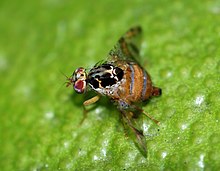This article needs additional citations for verification. (September 2019) |
| Ceratitis capitata | |
|---|---|

| |
| Female, with ovipositor visible at the end of the abdomen | |
| Scientific classification | |
| Domain: | Eukaryota |
| Kingdom: | Animalia |
| Phylum: | Arthropoda |
| Class: | Insecta |
| Order: | Diptera |
| Family: | Tephritidae |
| Genus: | Ceratitis |
| Species: | C. capitata
|
| Binomial name | |
| Ceratitis capitata (Wiedemann, 1824)
| |

Ceratitis capitata, commonly known as the Mediterranean fruit fly or medfly, is a yellow-and-brown fly native to sub-Saharan Africa. It has no near relatives in the Western Hemisphere and is considered to be one of the most destructive fruit pests in the world.[1] There have been occasional medfly infestations in California, Florida, and Texas that require extensive eradication efforts to prevent the fly from establishing itself in the United States.[1]
C. capitata is the most economically important fruit fly species because of both its ability to survive cooler climates more successfully than most other fruit fly species and its ability to inhabit more than 200 tropical fruits and vegetables to which it causes severe destruction and degradation.[1] The practices that are used to eradicate the medfly after its introduction into a new environment can be extremely difficult and expensive, but infestation of C. capitata lowers crop yields and induces costly sorting processes for fresh fruits and vegetables.[1]
- ^ a b c d Thomas MC, Heppner JB, Woodruff RE, Weems HV, Steck GJ, Fasulo TR (July 2001). "Mediterranean Fruit Fly, Ceratitis capitata (Wiedemann) (Insecta: Diptera: Tephritidae)" (PDF). DPI Entomology Circulars. Florida Department Agr Cons Serv.